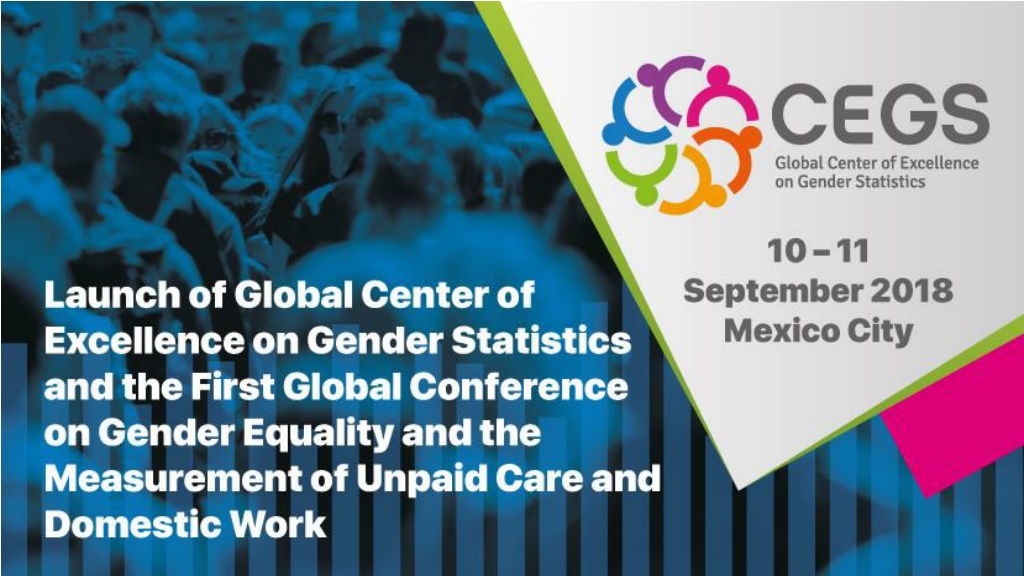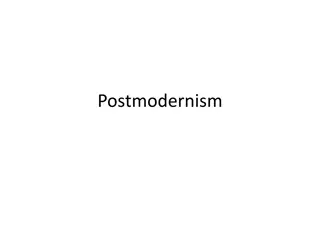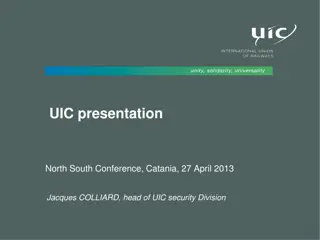
Insights from Global Time-Use Surveys Analysis
Explore methodological lessons from a comprehensive analysis of national time-use surveys conducted worldwide, including insights on survey databases, regional variations, and specific countries. Learn about the diverse approaches and findings in this extensive study by Jacques Charmes.
Download Presentation

Please find below an Image/Link to download the presentation.
The content on the website is provided AS IS for your information and personal use only. It may not be sold, licensed, or shared on other websites without obtaining consent from the author. If you encounter any issues during the download, it is possible that the publisher has removed the file from their server.
You are allowed to download the files provided on this website for personal or commercial use, subject to the condition that they are used lawfully. All files are the property of their respective owners.
The content on the website is provided AS IS for your information and personal use only. It may not be sold, licensed, or shared on other websites without obtaining consent from the author.
E N D
Presentation Transcript
Methodological lessons drawn from a worldwide analysis of national time-use surveys Jacques Charmes
Basis of the analysis Basis of the analysis Database of 133 surveys in 76 countries National surveys based on diaries or extended list of stylised questions (more than 15 activities) Modules of multi-purpose living conditions surveys with short and incomplete list of activities are excluded Only 11 countries (14 surveys) are based on lists of stylised questions Jacques Charmes
Northern, Western and Southern Europe (22 countries /42 surveys) South-Eastern Asia and the Pacific (4 countries Sub-Saharan Africa (10 countries Central and Western Asia (5 countries /6 surveys) Eastern Europe (6 countries/7 surveys) Northern America (2 countries /19 surveys) North Africa (3 countries /3 surveys) Arab countries (4 countries /5 surveys) Eastern Asia (5 countries /12 surveys) Southern Asia (3 countries /3 surveys) Latin America (12 countries /15 surveys) List of time List of time- -use surveys by year and region use surveys by year and region /13 surveys) /9 surveys) Canada (1992) (1998) (2005) (2010) (2015) Title Oman (2007-08) Occupied Palestinian Territory Iraq (2007) Benin (1998) (2015) Australia (1992) (1997) (2006) Argentina (Buenos Aires) (2005) Albania (2010-11) Belarus (2014-15) Algeria (2012) India (1998-99) China (2008) Armenia (2008) Morocco (2011-12) Azerbaijan (2008) (2012) Austria (2008-09) Japan (2001) (2006) (2011) (2016) Iran, Islamic Republic (2009) Cameroon (2014) Cambodia (2004) Chile (2015) Bulgaria (2009-10) United States (2003) (2004) (2005) (2006) (2007) (2008) (2009) (2010) (2011) (2012) (2013) (2014) (2015) (2016) Belgium (1999) (2005)(2013) Korea, Republic of (1999) (2004) (2009) (2014) New Zealand (1998-99) (2009-10) Hungary (1999- 2000) (2009-10) Tunisia (2005-06) Kazakhstan (2012) Colombia (2012-13) TEXT (1999-2000) (2012-13) Qatar (2012-13) Pakistan (2007) Cabo Verde (2012) Denmark (2001) Estonia (1999-2000) (2009-10) Mongolia (2007) (2011) Taiwan, China (2004) Thailand (2004) (2009) (2014-15) Moldova, Republic of (2011-12) Poland (2003-04) Finland (1979) (1987) (1999) (2009) Ethiopia (2013) Kyrgyzstan (2010) Costa Rica (2004) Turkey (2006) (2014-15) France (1974) (1986) (1999) (2010) Germany (2001-02) (2012) Ghana (2009) Cuba (2001) Madagascar (2001) Ecuador (2012) Romania (2011-12) Mali (2008) El Salvador (2010) Greece (2013-14) Ireland (2005) Italy (1988-89) (2002-03) (2008-09) (2013-14) Mexico (2002) (2009) (2014) Mauritius (2003) South Africa (2000) (2010) Panama (2011) Latvia (2003) Lithuania (2003) Tanzania, United Republic of (2006) (2014) Paraguay (2016) Macedonia, Former Yugoslav Republic of (2014-15) Peru (2010) Netherlands (2005-06) Uruguay (2007) (2013) Norway (1970) (1980) (1990) (2000) (2010) Portugal (1999) Serbia (2010-11) Slovenia (2000-01) Spain (2002-03) (2009-10) Sweden (2000-01) (2010-11) United Kingdom (2000) (2005) (2015) Presenter
Variations in methodologies Variations in methodologies Diary versus list of stylised questions For the surveys with lists of stylised questions, the variations that need to be interrogated are: the total number of questions/activities as well as the number of questions in each of the main activities distinguished by the classification used The duration of the reference period is also interesting to be tested (day, week or month) Another important issue to be checked is whether the list of questions covers all the range of activities (paid/unpaid/personal) or not For surveys based on diaries, one important issue is the length of the time slot (one hour, half an hour, 15 minutes, no time slot) and the number of activities that can be taken into account within the time slot (only one, two, three, four, five?) Jacques Charmes
Example of a diary: Ghana 2009 Example of a diary: Ghana 2009
Example of a stylised question: Mexico 2014 Example of a stylised question: Mexico 2014
Number Number of activities or questions of activities or questions in in time time- -use use surveys surveys and classifications and classifications CAUTAL Chile Colombia Costa Rica Ecuador Mexico Paraguay Peru ICATUS Paid work Production of gods for own final use Total paid work 8 3 4 2 3 4 2 20 15 9 15 9 5 24 23 3 4 11 18 13 7 44 Domestic services 27 22 22 4 51 34 10 51 30 Care of household members Care of other household, community, volunteering Total unpaid care work Education 32 46 13 1 25 26 27 23 23 9 8 11 1 7 8 16 14 68 76 46 6 83 68 37 90 67 6 4 1 4 3 7 9 Other 23 19 19 4 24 18 8 24 45 Total (excluding paid work) 97 99 65 16 111 89 45 128 121
Methodological variations across Methodological variations across surveys and countries surveys and countries In both types of surveys (diaries/questions) several variations are to be looked at: How weekdays and weekends are treated? What about seasonal variations? How simultaneous activities are treated? Is the questionnaire administered to all household members above a certain age or only to a sub-sample? Is the non-response rate analysed, taken into account and used for correcting the sample weights?
Stylised questions Stylised questions and simultaneous activities and simultaneous activities In questionnaires with lists of stylised questions, it is likely that respondents take simultaneous activities systematically into account The Mexican survey for example insists on indicating the time dedicated to each activity In Costa Rica, a final question is asked to know whether some activities (care of the sick, of children, ) have been undertaken simultaneously and for how long Charts hereafter show a concentration of surveys using lists of stylised question at the top of the distribution of time spent in unpaid care activities, and in top right angle of countries with high female activity rates and longer time spent in unpaid care work, whereas countries at the bottom right angle are characterised by low female activity rates (Arab countries, Middle East North Africa)
Time spent by women Time spent by women in in in 75 countries 75 countries Cabo Verde in unpaid care work unpaid care work Colombia Chile Iraq Moldova, Republic of Tunisia Algeria Australia Lithuania Italy Serbia Morocco India Occupied Palestinian Territory Belarus Pakistan Ireland Mauritius Kyrgyzstan Ecuador Austria Romania Spain Canada Japan New Zealand Denmark Sweden China United Kingdom South Africa Macedonia, Former Yugoslav Rep. Benin Paraguay Cameroon Qatar Korea, Republic of Women unpaid care work Taiwan, China 0 100 200 300 400 500 600 Minutes per day Presenter
Distribution of Distribution of the 75 countries the 75 countries by women s rates rates and time spent by women in unpaid care work and time spent by women in unpaid care work by women s activity activity 80 Cambodia Ethiopia Tanzania 70 Peru 60 Colombia Uruguay Women's activity rate 50 Chile Cabo Verde Mexico 40 Costa Rica Turkey 30 Morocco Tunisia Pakistan Oman 20 Iraq Palestine Algeria Iran 10 0 100 150 200 250 300 350 400 450 500 Time spent by women in unpaid care work (in minutes per day) Jacques Charmes
Sample of individuals and Sample of individuals and non response rates non response rates Surveys generally indicate non response rates for households but not systematically non response rates for individuals In time-use surveys where proxy respondents cannot fill the diaries for other household members or respond to the stylised questions, it is important to check whether the population of individuals fits with the general population, because it is likely that non-respondents are often active persons whose absence will have an impact on the global results of the survey
Classifications (1) Classifications (1) In countries where the list of stylised questions is used, the classification of activities designs the ideal number of questions while the groupings and sub-groupings ensure that there is a common understanding of the various concepts of unpaid care work, domestic work and care for household members For countries using the diary, the classification is a tool in support of the interviewers for the codification of the activities declared by the interviewees (or in support of the interviewees in the case self-filling diaries At the first digit level, the number of items indicate the importance given to some specific activities: the trial ICATUS distinguished 5 main activities of SNA work, finally reduced to 2 in the final ICATUS (employment and production of goods for own final use). The ATUS identifies telephone calls, emails and mails at the one-digit level
Classifications (2) Classifications (2) ICATUS and CAUTAL give emphasis of production of goods for own final use whereas work is limited to employment in HETUS and ATUS Therefore the use of HETUS is not appropriate in countries where production of goods for own final use is extended: care of domestic animals has not the same meaning in developed countries (caring of pets is not a SNA productive activity) and in developing countries (feeding the poultry or milking the cow are SNA productive activities)
Trial ICATUS ICATUS HETUS ATUS CAUTAL 01 - Work for corporations/quasi- corporations, non-profit institutions and government (formal sector work) 02 - Work for household in primary production activities 03 - Work for household in non-primary production activities 04 - Work for household in construction activities 05 - Work for household providing services for income 06 - Providing unpaid domestic services for own final use within household 07 - Providing unpaid caregiving services to household members 1 Employment and related activities 1 Employment 7 Working and work-related activities 1 Trabajo Remunerado (en la Frontera de Producci n del SCN) 2 Actividades Relacionadas Con el Trabajo Remunerado 2 Production of goods for own final use 3 Unpaid domestic services for household and family members 4 Unpaid caregiving services for household and family members 3 Household and Family Care 3 Household activities 4 Purchasing goods and services 3 Trabajo No Remunerado en Quehaceres del Hogar Para su Propio Uso 4 Cuidado No Remunerado a Miembros del Hogar 5 Trabajo No Remunerado Para Otros Hogares, Para la Comunidad y Trabajo Voluntario No Remunerado 6 Aprendizaje y Estudio 7 Convivencia, Cultura, Aficiones y Deporte 5 Caring for and helping household members 6 Caring for and helping non household members 08 - Providing community services and help to other households 5 Unpaid volunteer, trainee and other unpaid work 4 Voluntary Work and Meetings 09 - Learning 10 - Socializing and community participation 6 Learning 7 Socializing and communication, community participation and religious practice 8 Culture, leisure, mass-media and sports practices 2 Study 5 Social Life and Entertainment 8 Educational activities 9 Organizational, civic, and religious activities 11 Telephone calls, mail, and e-mail 11 - Attending/visiting cultural, entertainment and sports events/venues 12 - Hobbies, games and other pastime activities 13 - Indoor and outdoor sports participation and related courses 14 - Mass media 6 Sports and Outdoor Activities 7 Hobbies and Computing 10 Leisure and sports 8 Utilizacion de Medios de Comunicaci n 9 Cuidados Personales 15 Personal care and maintenance 9 Self-care and maintenance 0 Personal Care 1 Personal care activities 2 Eating and drinking 12 Other activities, not elsewhere classified Jacques Charmes 9 Travel and Unspecified Time Use
Conclusions for measurement of Conclusions for measurement of unpaid care work unpaid care work The main question is the treatment of simultaneous activities that cannot be simply added up and valuated as the main activities In this respect the technique of diary is more appropriate than the list of stylised questions But results for simultaneous activities are rarely systematically published in official reports. Efforts should be made in this respect The treatment of production of goods for own final use is still ambiguous: whereas these activities (including water and firewood fetching) are officially part of the measured GDP, their inclusion in unpaid care work can be misleading because it would mean that such activities would accrue an indicator of unpaid work that is supposed to be compared with a measure of GDP that excludes it.
Thank you for your attention Thank you for your attention Jacques.charmes@yahoo.com






















